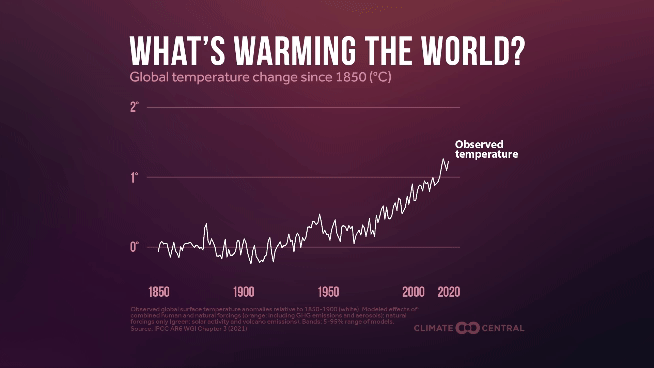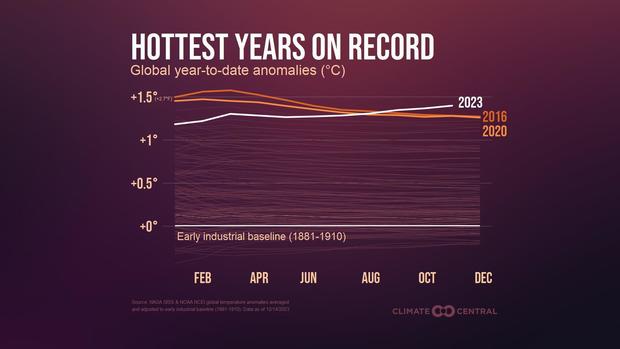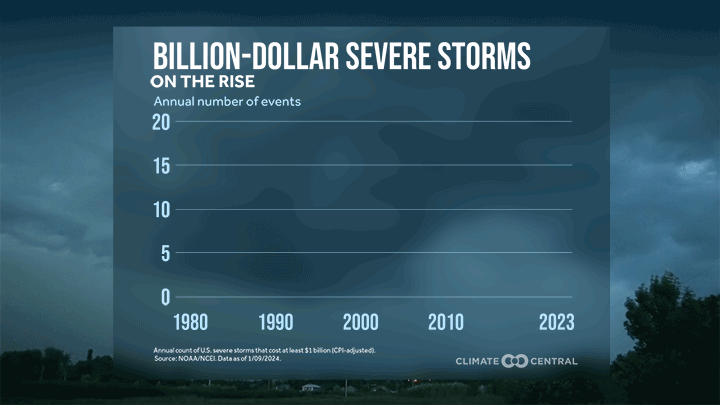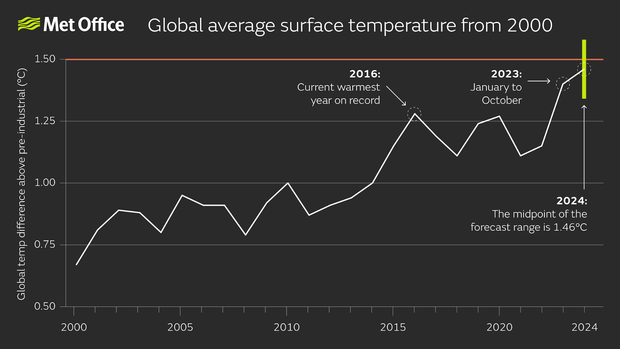2023 was officially the hottest year ever. These charts show just how warm it was — and why it's so dangerous.
The first few days of the new year brought confirmation of some disturbing news: 2023 was the hottest year ever recorded. Researchers had that would be the case amid relentless daily and monthly record-breaking temperatures — but just how significant were the numbers, and what does it mean for the future of our warming planet?
These charts paint a clear picture of how it happened, as well as what's likely to come in the not-so-distant future.

How hot was 2023?
Copernicus, the European Union's climate agency, confirmed this week that 2023 saw a global average temperature of 14.98 degrees Celsius, nearly 59 degrees Fahrenheit. That temperature was 0.17 degrees Celsius higher than the previous record-breaking year in 2016. Climate records are "tumbling like dominoes," Copernicus deputy director Samantha Burgess said.
Compared to the average pre-industrial level from 1850 to 1900, last year was 1.48 degrees Celsius warmer, Copernicus found.
"Not only is 2023 the warmest year on record, it is also the first year with all days over 1°C warmer than the pre-industrial period," she said. "Temperatures during 2023 likely exceed those of any period in at least the last 100,000 years."

What's causing the increase? According to data analyzed by scientists at the nonprofit Climate Central, it's a combination of factors. Natural causes do provide some variation in temperature, but humans have had a far more significant impact on the observed temperatures seen over this period.
In the last 100 years, humans burning fossil fuels have released carbon dioxide — one of the most potent planet-warming greenhouse gases — "at a far faster rate than any point in the previous 800,000 years of Earth history," Climate Central says.
"The main cause of rapid global warming today is heat-trapping pollution from human activities," the group explains. "...This year's record global average temperatures reflect extreme and often dangerous heat events driven by human-caused climate change."
1 degree Celsius — a small number with a big impact
Copernicus found that 2023 was the first year in recorded history in which every single day exceeded 1 degree Celsius above the pre-industrial level. Nearly half of those days were more than 1.5 degrees warmer, and two days — both in November — were more than 2 degrees warmer.
The data show that in the second half of 2023, every month was warmer than that same month in any previous year, with July and August being the warmest two months on record. Climate Central found that every single day in July, one-quarter of the entire global population "felt a very strong influence of climate change," including 31 consecutive days of 110-degree Fahrenheit temperatures in Arizona, unprecedented ocean temperatures off South Florida, and large scale agricultural losses.

Record warm sea surface temperatures
It wasn't just hot in the air last year, but in the sea, too. Copernicus found that 2023 saw the highest daily global sea surface temperature ever recorded by ERA5, their climate reanalysis system. According to the group, sea surface temperatures usually peak in March and then see another uptick in July and August. But last year, every month from April through December saw their highest-ever levels, with the peak for the year being 21.02 degrees Celsius, or just under 70 degrees Fahrenheit, on Aug. 23 and 24.
The climate pattern known as El Niño formed last year, contributing to global heat, but the natural event has so far not been as strong as the ones experienced in 2015 and 1997, Copernicus said.
Record number of billion-dollar storms in 2023
A rise in temperatures throughout the world's air and oceans acts as fuel for extreme weather, making hurricanes, rain storms, droughts and other weather events stronger and more frequent. NOAA found that in 2023, the U.S. had 28 weather or climate disasters that each caused $1 billion or more in damage, far surpassing the previous record of 22 set in 2020.

Up until around 2008, the number of annual billion-dollar storms didn't surpass five, and it has sharply increased ever since.
At the same time, the number of days between these major disasters has decreased, Climate Central found. In the 1980s, there tended to be between roughly 60 and 100-plus days between major events. In 2023, they happened every couple of weeks.
2024 – another year of expected climate impacts
Last year was hot, but experts agree that 2024 could be even hotter. The U.K.'s Met Office released an outlook in December that suggests this year will be another one that breaks records, especially with a temperature boost brought on by El Niño. According to Met Office scientists, 2024 will likely be between 1.34 degrees Celsius and 1.58 degrees Celsius above the pre-industrial average. If that happens, it would mark the 11th consecutive year that global average temperatures were at least 1 degree Celsius above pre-industrial levels.

The Met Office's Nick Dunstone said there's a "reasonable" chance that 2024 will exceed the 1.5 degree Celsius threshold that climate scientists have long warned would bring an era of even more disastrous weather events worldwide.
"It's important to recognise that a temporary exceedance of 1.5 °C won't mean a breach of the Paris Agreement," he said in a Met Office statement, referring to the agreement of world leaders to commit to actions that would prevent passing this threshold. "But the first year above 1.5 °C would certainly be a milestone in climate history."
Officially passing the threshold would require a long-term average, not just the average for a single year. However, as temperatures continue to climb, the impacts would also continue to worsen.
- In:
- Climate Change
- Heat

Li Cohen is a social media producer and trending content writer for CBS News.
Disclaimer: The copyright of this article belongs to the original author. Reposting this article is solely for the purpose of information dissemination and does not constitute any investment advice. If there is any infringement, please contact us immediately. We will make corrections or deletions as necessary. Thank you.
Title:2023 was officially the hottest year ever. These charts show just how warm it was — and why it's so dangerous.
Url:https://www.investsfocus.com







